Without a doubt, a strong drive for great numbers is at the heart of any high-performing sales team.
But the secret to closing great deals is about more than having high-performing salespeople on your team.
Salespeople are busy.
Between prospecting, sales calls, data entry, quote preparation, and follow-ups, it’s very easy for teams to mismanage data and trip over themselves on the way to the finish line.
That’s why sales collaboration tools are an essential part of the modern sales lifecycle.
In this article, we’ll cover the top sales and creative collaboration tools that you should consider when trying to keep your team focused and on track.
All of these versatile tools on our list have one thing in common: they can drastically improve workplace productivity and efficiency.
Let’s jump right in!
Key takeaways
- Sales collaboration tools are designed to help sales team members manage data and sales workflows efficiently.
- Best overall: PandaDoc
- Best for customer engagement: Salesloft
- Best for team communication: Slack
- Best for CRM integration: Salesforce
- Best for automation: HubSpot Sales Hub
- Best for visual collaboration: Miro
- Best for project management: monday.com
Sales rep collaboration tools enhance both remote and in-office teamwork
Most “sales teams” consist of individual salespeople managing their own accounts through the entire sales pipeline.
Although many reps may not work closely as a team, they still need to share databases, customer information, and overall team goals.
And (obviously!) they can never lose sight of maximizing the customer experience.
Salesforce says 88% of customers value experience as much as product quality, and HubSpot finds that a single bad service experience can lose up to 40% of customers.
The right tech stack maximizes your team’s efficiency in sales, service, and retention.
Collaborative software tools typically come with onboard functionality to help team members manage data and sales workflows more effectively.
Combined with automation features, file sharing, and more, these tools allow for better team cohesion and greater productivity.
Whether sales development reps are back at company offices or continue to work remotely, they need to manage a robust sales pipeline and drive deals further down the funnel.
1. PandaDoc
As an all-in-one document management solution, PandaDoc helps businesses of all sizes streamline their sales proposals, quotes, contracts, and more.
The platform’s secret weapon is the PandaDoc document editor, which allows users to make quick, real-time edits and changes to documents during the sales process without having to take the documents offline and upload a new version.
Pros:
- Complete document lifecycle management in one place
- Supports document editing from Word, Google Docs, etc.
- Highly customizable integrations and custom templates
- Unlimited documents and e-signatures for all plans
- Payment gateways are always available
- Document tracking features help users stay on the same page
- A free trial is available
Cons:
- Full use of features requires a paid tier; however, ample time to test the product during 14-day free trial
- Date and timezone settings might cause the document creation date to sometimes display incorrectly
G2 Rating: 4.6/5
Capterra Rating: 4.5/5
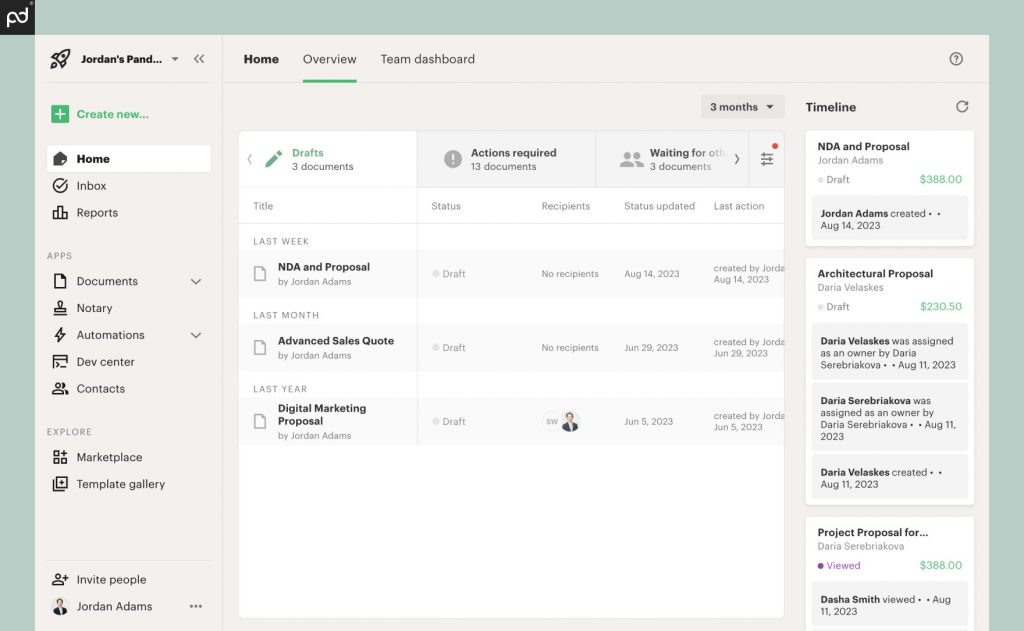
PandaDoc can import files directly from Word or Google Docs for complete editorial functionality.
That, combined with file storage, template tools, and integration with a preferred CRM, makes it a powerful tool for handling all business documentation.
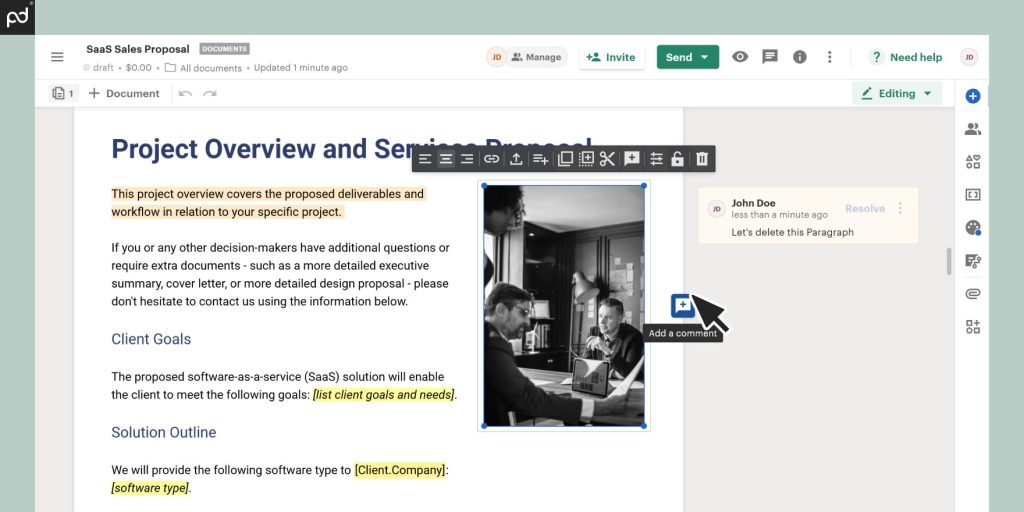
On top of that, the native integration tools will allow you to connect PandaDoc to the rest of your tech stack, so it’s easier than ever for businesses to use their preferred tools and combine them with the PandaDoc platform.
| Essentials | Business | Enterprise |
|---|---|---|
| $19 per month per user | $49 per month per user | Custom pricing solution |
| 1. Unlimited legally binding eSignatures with audit trail 2. Unlimited docs and templates 3. Rich media drag and drop document editor 4. Real-time tracking and document insights |
All the Essentials plan features plus: 1. Unlimited documents and eSignatures 2. CRM integration for HubSpot, Pipedrive and more 3. Content library 4. Custom branding 5. Approval workflows |
All the Business plan features plus: 1. Single sign-on (SSO) 2. Salesforce and Zapier integrations 3. Team workspaces and custom user roles 4. Redlining and versioning 5. Performance reporting |
| Start a free trial | Start a free trial | Contact sales |
2. Salesloft
Salesloft is a powerful sales enablement tool that equips your team with the essentials for better customer engagement, consolidating data into a single platform.
Pros:
- Full-scope platform for all aspects of the sales cycle
- Better pipeline management and onboarding tools
- Powerful analytics and reporting functionality
Cons:
- User functionality and metric tracking can be limiting
- Dialer feature and call logging could be more streamlined
- Packet loss can cause problems when logging information
G2 Rating: 4.5/5
Capterra Rating: 4.4/5
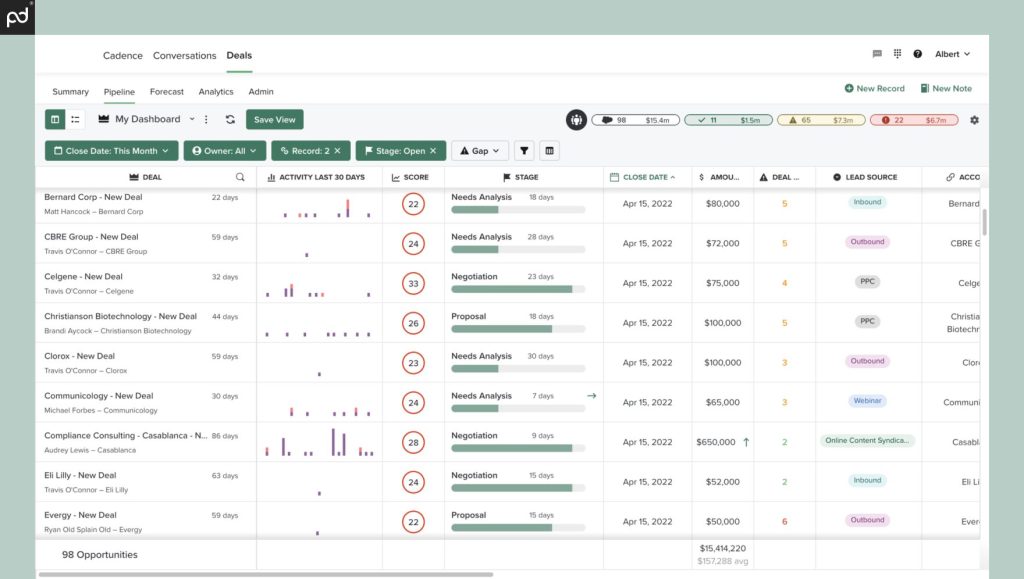
Salesloft streamlines the sales funnel by integrating multiple automation and insight tools, enhancing the entire sales process from demo to contract.
Doing so eliminates the need for reps to switch between windows, resulting in a more efficient and complete sales process.
Pricing is customized based on the desired functionality, with packages for lead generation, deal closing, engagement, and more.
This flexibility suits smaller organizations needing specific features, as well as comprehensive options for larger enterprises.
3. Salesforce
There are some benefits to being one of the biggest players in the market when it comes to CRM software tools.
As an online collaboration tool, Salesforce is great because it’s the de facto CRM tool on the market and has been for some time.
There are other tools out there (like HubSpot, featured later in this list), but they’re often combined with some other sales suite or embedded in another platform.
Pros:
- The definitive CRM tool for businesses
- Many tools offer Salesforce integration and compatibility
- Offers a huge variety of customizations for data capture
Cons:
- Pricing is convoluted and can be difficult to understand
- The flexibility of the system means that you’ll need to manage how your team uses the platform to make sure that everyone is on the same page
G2 Rating: 4.5/5
Capterra Rating: 4.3/5
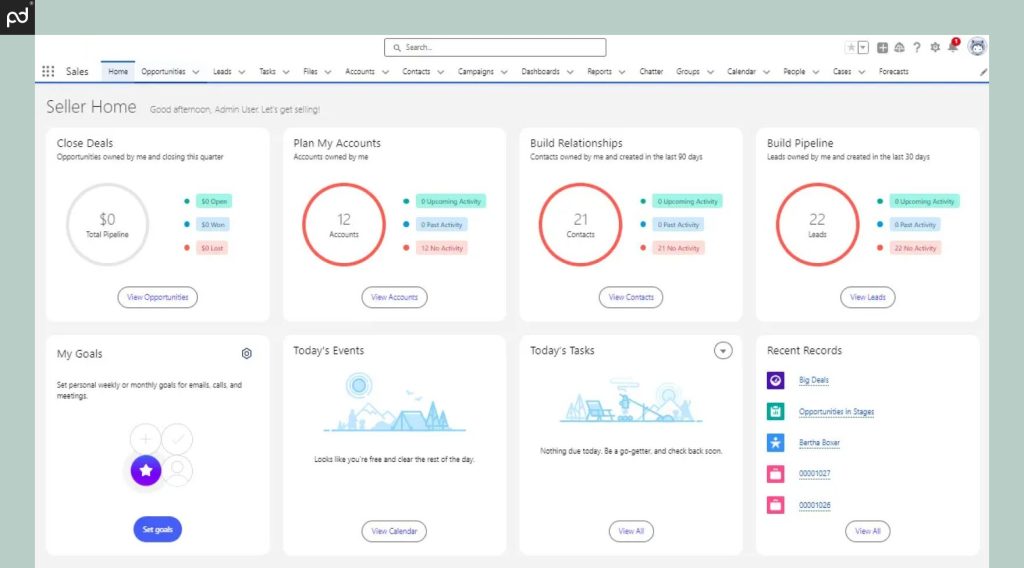
Salesforce offers three pricing plans: $25/per user/per month for Platform Starter, $100/per user/per month for Platform Plus, and Platform Unlimited with custom-tailored pricing.
At its core, Salesforce is a CRM tool designed to help your sales team capture and store customer information.
The wide range of flexibility and customization means that sales managers have a huge amount of flexibility when determining how data is captured and what data is important.
Plus, Salesforce integrates with most other platforms out there, including PandaDoc.
However, the flexibility of the software is also its Achilles heel.
Pricing can be confusing and convoluted, and it can be difficult to figure out what you need, how you’re being charged, or what should be charged based on the plan that you have.
The same is true for the CRM itself.
Because the system allows you to set up customized layouts that work for your business, it’s not designed to be a plug-and-play solution.
Instead, you’ll have to set everything up so that your intake flow makes sense and then ensure that your team is capturing all the appropriate information during calls.
4. Slack
Slack, now part of Salesforce, simplifies team communication with features reminiscent of early Internet Relay Chat (IRC).
Slack offers plans ranging from free to $6.67/user/month for Standard, $12.50/user/month for Plus, and custom pricing for enterprises.
Pros:
- User interface is slick and intuitive
- Great flexibility when setting up workspaces and rooms
- Integrated call and video conferencing tools
Cons:
- Finding old threads and conversations can be tedious, even when using the onboard search tool
- Free plan comes with limited storage, which fills up fast
G2 Rating: 4.5/5
Capterra Rating: 4.7/5
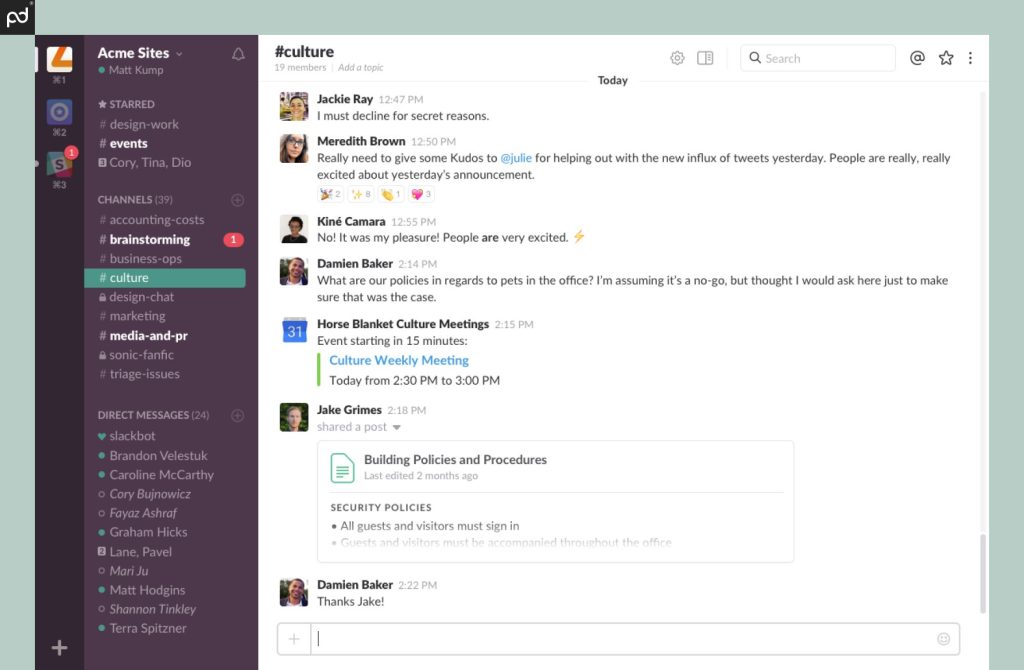
Primarily a text-based chat platform, Slack also supports video calls, file sharing, and integration with tools like Dropbox, Evernote, and Trello.
It’s ideal for initiating projects, hosting online meetings, and keeping remote sales teams connected.
Slack is also a powerful tool for sales, enabling custom chat rooms for collaborative workspaces with prospects.
Its flexible meeting functionalities allow reps to connect on their terms, avoiding lengthy calls.
With a mobile app for on-the-go access, Slack ensures a seamless user experience with minimal flaws.
5. HubSpot Sales Hub
When talking about HubSpot, it’s easy to get lost in the sheer amount of tools that they have to help sales and marketing teams succeed.
As a sales team collaboration tool, there are few options out there with the features and functionality that HubSpot can provide.
Pros:
- Sales tracking is fast, easy, and efficient
- Automation and workflow optimization are huge time savers
- Intuitive and friendly UI
Cons:
- Feature use feels somewhat limited
- Expensive compared to competitors
- Finding hidden features is a common problem
G2 Rating: 4.4/5
Capterra Rating: 4.5/5
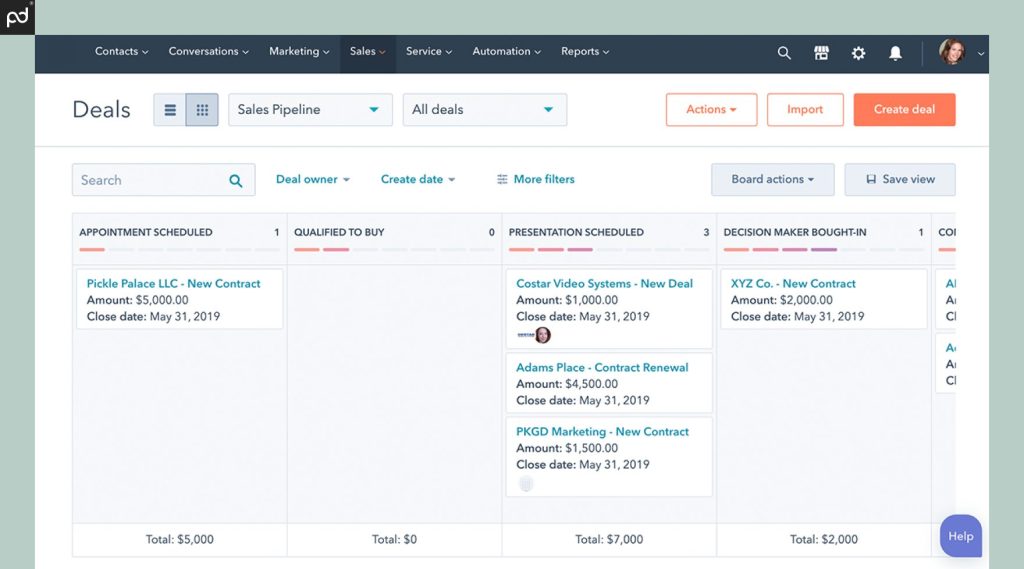
HubSpot CRM plans range from free with limited features to $20/seat/month for Starter, $100/seat/month for Professional, and $150/seat/month for Enterprise.
HubSpot Sales Hub automates, manages, and personalizes sales workflows, allowing task queues, personalized messaging, chats, and video outreach.
Its CRM goes beyond traditional features, enabling deal creation, email tracking, document management, and call recording.
Ideal for both large and small teams, HubSpot simplifies sharing customer information and managing deal pipelines, transforming your CRM into a comprehensive sales suite.
6. Chilli Piper
Why is a meeting scheduler on our list of top sales collaboration tools?
Chili Piper boosts conversions and speeds up deal closures by streamlining the scheduling process for top-performing sales teams.
Pros:
- Easy to set up and use
- Integration with other big products (Salesforce, Google Calendar, etc.)
- Support is typically fast and accurate
Cons:
- Slow load times
- Customization can be a challenge
G2 Rating: 4.6/5
Capterra Rating: 4.4/5
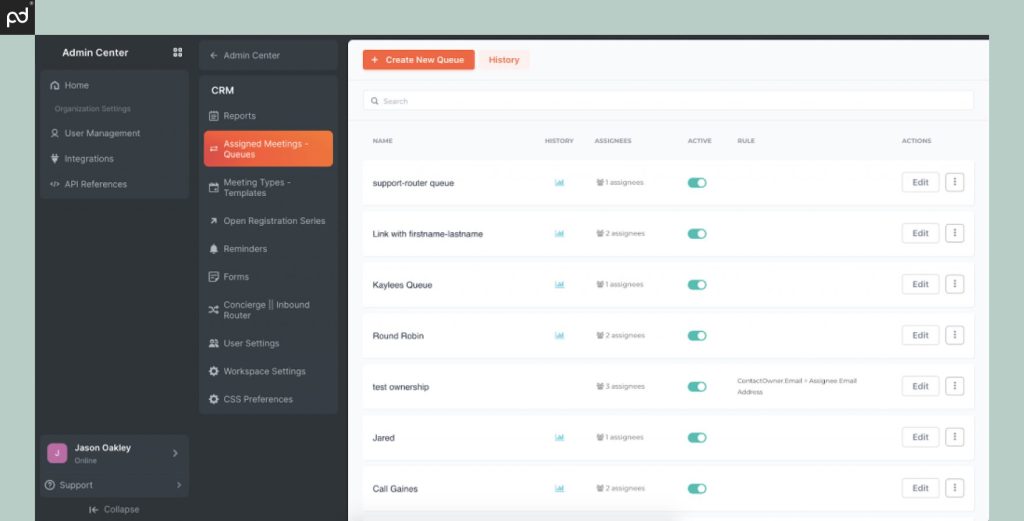
Beyond scheduling, Chili Piper distributes inbound leads among SDRs, schedules follow-ups and handoffs quickly, and automatically updates your CRM, eliminating tedious data entry.
Chili Piper pricing: $15/user/month for Instant Booker, $25/user/month for Handoff, $30/user/month for Distro, and $30+/user/month for Concierge.
For efficient lead generation and face-to-face time with prospects, add Chili Piper to your sales workflow to streamline inbound leads.
7. Zoominfo
Finding strong, credible leads can be a headache, especially when cold-calling without insight into a company’s structure.
ZoomInfo simplifies prospecting by providing enriched leads, offering valuable information before your sales team starts dialing.
Pros:
- Robust search engine and contact database
- Great filtering and export tools for contact data
Cons:
- Exported data doesn’t correctly import into other CRM tools
- Data can be inaccurate
- Its interface can be slow
G2 Rating: 4.4/5
Capterra Rating: 4.1/5
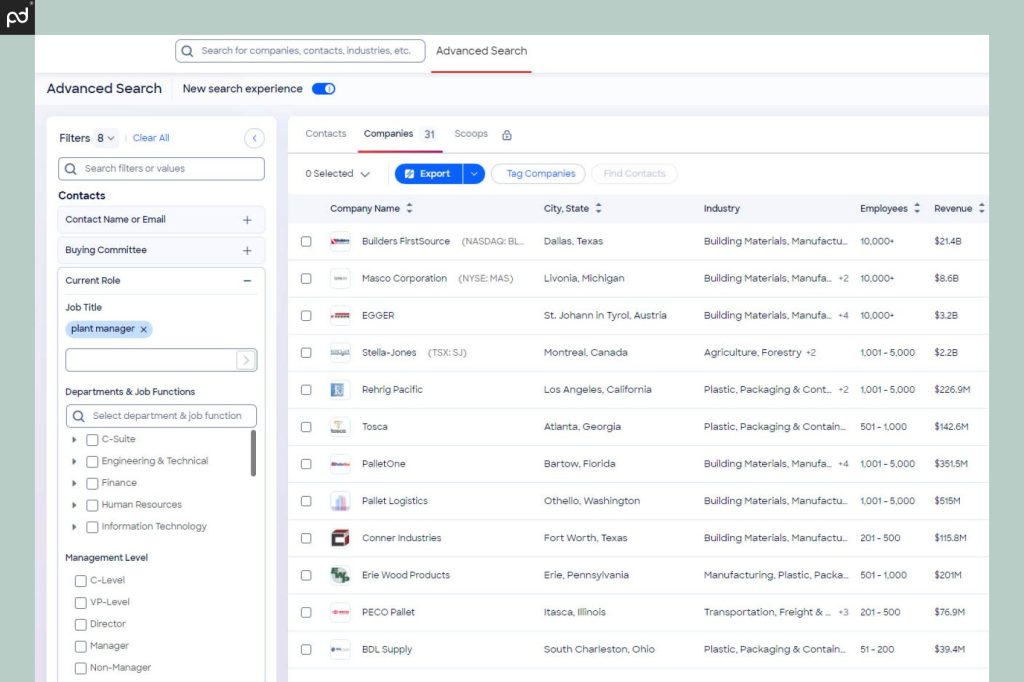
ZoomInfo facilitates collaboration by making it easy for one person to find company stakeholders and decision-makers without burdening the rest of the team.
Exporting data to your CRM ensures your team has the necessary information for effective interactions.
While we can’t say all ZoomInfo data is guaranteed to be perfectly accurate, the platform saves time and helps align your team with company objectives.
Advanced plans offer insights like department org charts, purchasing intent data, and corporate hierarchy data, giving your reps a better understanding of prospects’ roles and needs before they call.
8. Monday.com
We couldn’t have a complete list of collaboration tools without talking about monday.com.
This beloved CRM platform allows you to handle everything from lead capture to customer onboarding with easily customizable pipelines and user flows.
Pros:
- Powerful task tracking and project management tool
- Easy for users to stay on target and on task
- Incredible customization options
Cons:
- The free version is very limited (only two users)
- Minimum seat size on paid plans may be frustrating for very small teams
G2 Rating: 4.7/5
Capterra Rating: 4.6/5
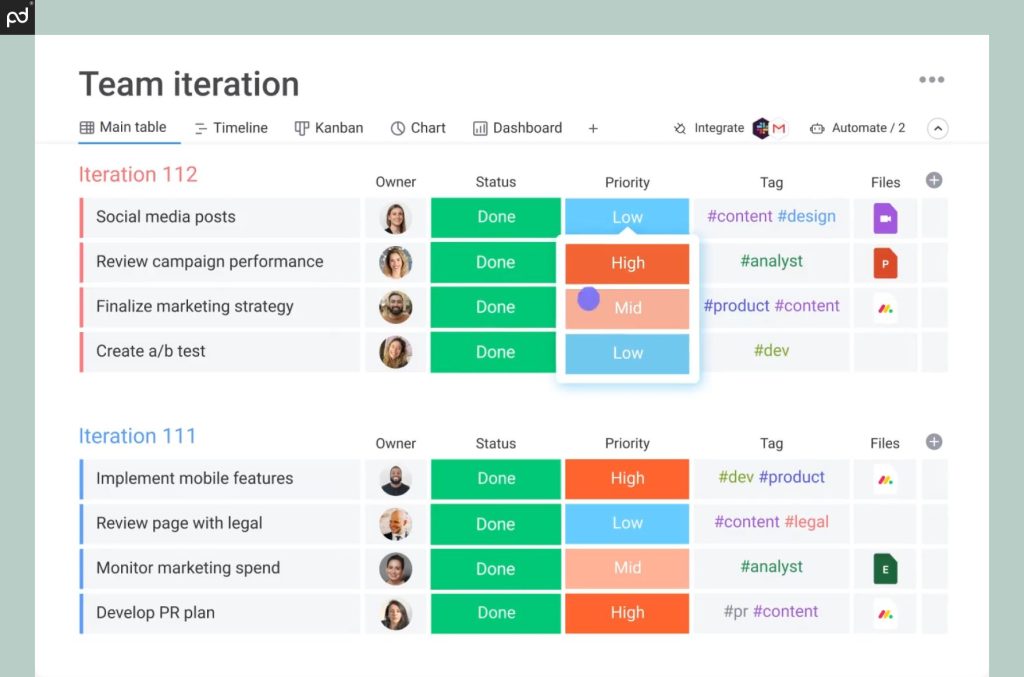
Monday.com pricing starts from Basic $9/per 4 seats/per month and goes up, with $12/per 3 seats/per month for Standard, $19 per 3 seats/per month for Pro, and custom-tailored pricing for Enterprise.
The versatility of the boards means that the software can handle anything from project and task management all the way to sales pipelines and CRM data capture.
Plus, monday.com comes armed with a robust selection of tools, including Kanban boards and Gantt charts for better visualization and workflow management.
The platform offers integration and automation tools and, more recently, a shared collaborative documentation feature to help teams share information in a single workspace.
This, in turn, helped it get into our list of the best document collaboration tools.
Furthermore, the platform offers team-wide visibility for managers, making it ideal for overseeing larger teams or those working across departments.
This shared visibility helps identify and address bottlenecks early, preventing major issues in the sales funnel.
In sales, monday.com manages everything from pre-sales to post-sales follow-ups.
It also integrates seamlessly with tools like Google Drive, Microsoft Teams, and Asana for additional functionality.
9. Miro
Miro is a collaborative whiteboard software for sales leaders to visualize strategies with their teams.
Offering a free trial, free plan, and paid plans starting at $8/month for Starter and $16/month for Business, Miro successfully nails it when catering to various needs.
Pros:
- Easily create charts, graphs, and visualizations
- Flexible tool with multiple use cases
- Can be used to collaborate with guests and freelancers
Cons:
- Boards can be tricky to set up, especially at first
- Data segregation only available on Enterprise plans
G2 Rating: 4.8/5
Capterra Rating: 4.7/5
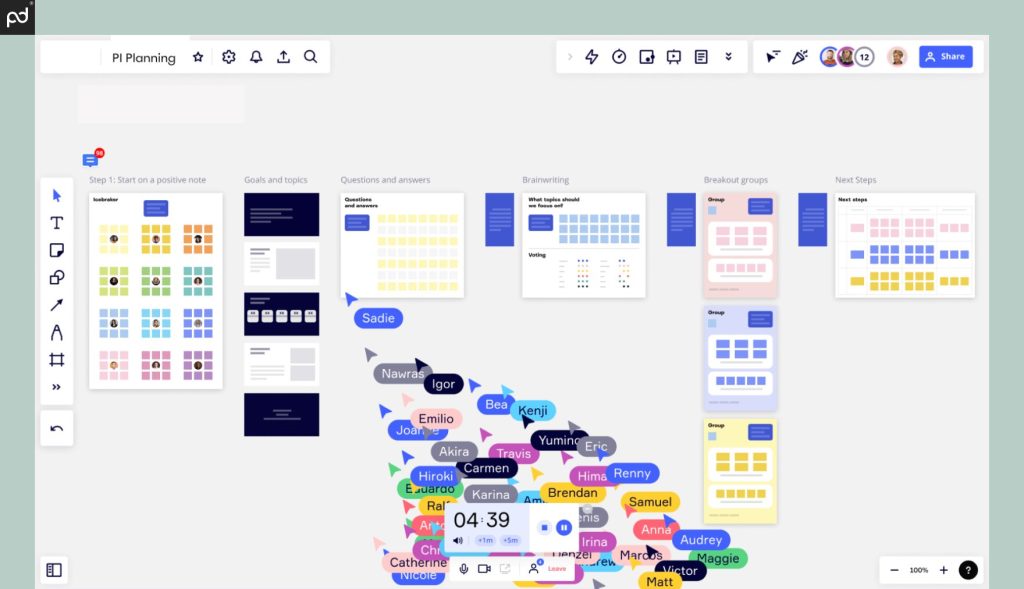
Rather than sending out long-form Word documents with a set of instructions about how to move the team forward, Miro promotes creating a better sales environment through more visually supported, hands-on knowledge sharing.
Building a board in Miro is simple.
You can use basic drag-and-drop tools to create everything from flowcharts to brainstorming layouts and more, depending on what visuals you need to create.
While you can export your charts and graphs and use them in a slide deck or presentation, you can also host meetings in Miro where you can manipulate your visuals to explain how your concepts work.
This level of flexibility also makes Miro a great tool for collaborative selling and building strong customer relationships.
In the same way that mentors and managers can introduce teams to ideas, sales teams can invite customers to their own boards to collaborate with them.
Miro supports guest accounts and easy link sharing, providing a hands-on experience for visual learners.
Content can be accessed anytime, allowing for post-meeting reviews.
Its flexibility makes it valuable across departments for sharing knowledge and celebrating sales successes.
10. SpatialChat
In a typical virtual meeting, attendees are in the same room with one person speaking, possibly using visuals or open discussions.
While most tools offer breakout rooms for smaller conversations, these can isolate team members.
SpatialChat addresses this by creating a virtual space that mimics real-life meetings using two unique features: visual meeting space and spatial audio.
Attendees see a top-down view of an office where they can move around and join different groups by clicking or tapping.
Pros:
- Virtual meeting space that emulates real-world meetings
- Spatial audio is a cool feature for limiting conversations
- Visual elements add a unique dynamic to meetings and chats
Cons:
- Missing some basic options, like a waiting room
- Lacks some admin controls and tiered user privileges
G2 Rating: 4.7/5
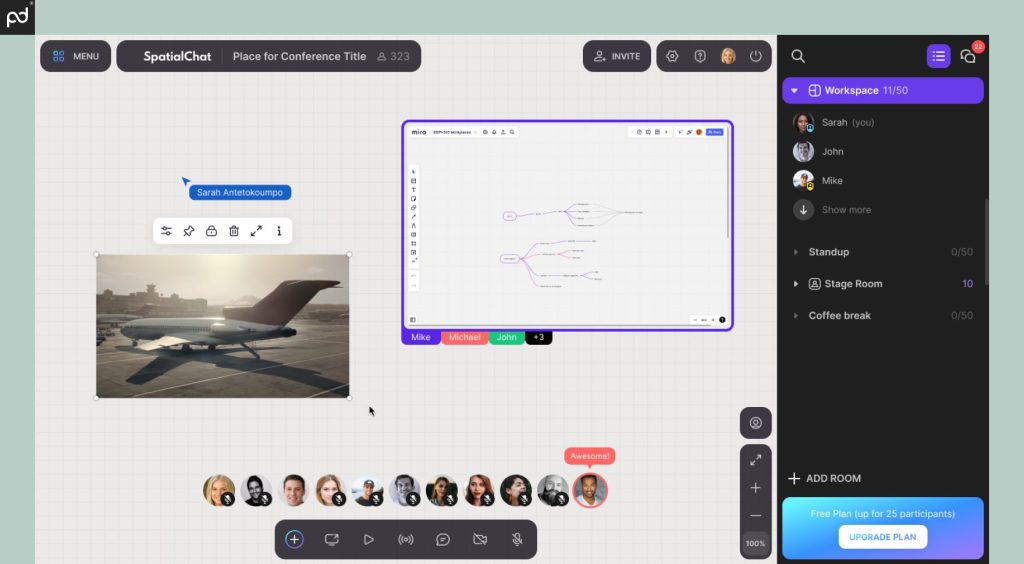
SpatialChat’s spatial audio ensures that proximity determines what participants hear, enabling natural group discussions.
This setup eliminates breakout rooms, creating a cohesive conference environment.
Admins can observe interactions, facilitating better team dynamics by intermingling top performers with newcomers.
SpatialChat also supports traditional video chats with full audio, suitable for various meeting types.
SpatialChat pricing includes a free plan (limited to 2 hours/day) and an unlimited package for 15-150 users starting at $499/year.
Consultants are available to help choose the best plan.
11. SalesRabbit
Designed for sales departments and direct sales teams, SalesRabbit keeps teams connected on the go.
Plans range from free for individual users to $29/user/month for small teams, $39/user/month for growing teams, and custom pricing for enterprises.
Pros:
- One of the go-to tools for direct sales teams
- AI tools give reps information before they visit a destination
- Digital contracting tools designed around in-home sales
Cons:
- Navigation tools aren’t as intuitive as they could be
- Can be a drain on device batteries
G2 Rating: 4.5/5
Capterra Rating: 4.3/5

SalesRabbit equips sales leaders with tools to track and manage teams while empowering reps to follow up with leads and close deals.
Its comprehensive AI provides customer information, helping reps understand their environment and target leads effectively.
From a management and collaboration perspective, SalesRabbit helps reps stay in their lane while working with one another.
The app offers team messaging tools so that reps can help one another out along the way and continue to build a collaborative culture.
At the same time, you can define sales territories on a visual map so that reps aren’t accidentally crossing into areas that are allocated to other team members.
These visual dashboards and area-defining tools allow for teamwork and a strong sales culture without the ultra-competitiveness that plagues many sales organizations.
And that’s a huge win for any sales team, whether they’re in the office or on the go.
12. Gong.io
Gong is a sales enablement tool that consolidates and analyzes customer communications for actionable insights to boost revenue.
Using AI, Gong turns conversations and emails into searchable data, helping to spot patterns that reps and managers can’t find on their own.
Pros:
- Consolidates sales data in one place for easy trend analytics and review
- Connects with most sales and meeting tools (Salesforce, Zoom, Teams, etc.)
- Mostly lives up to expectations by providing trackable optimizations and improvements for sales teams
Cons:
- Gong captures so much data that it can be hard to find what you want, even if you’re using filters
G2 Rating: 4.7/5
Capterra Rating: 4.9/5
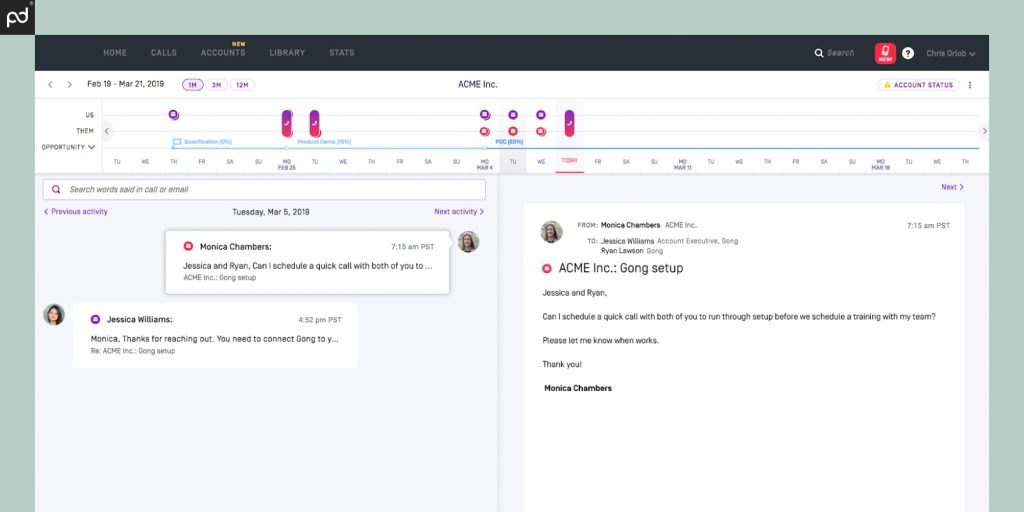
Gong streamlines breaking down silos and enhances team collaboration by systematically analyzing sales processes.
This eliminates the need for lengthy discussions, providing data-driven insights instead.
The tool also captures all sales information, making it easy to compare top performers and use this data for effective coaching.
In team environments, this objective approach to coaching and data consolidation can be a serious boost because it removes many objective biases due to team dynamics like seniority and/or favoritism.
With Gong, you can hold managers accountable for how they coach and reps accountable for how they sell, all while gathering insights that you wouldn’t have been able to access otherwise.
13. InsideSales
InsideSales’ Playbooks is a sales engagement platform that combines data insights with automation and workflow tools.
It creates a comprehensive sales framework and cadence backed by sales intelligence data.
Pros:
- Playbooks by InsideSales helps reps stay organized and on task
- Automation tools streamline sales workflows and increase output
- Unique insights influence how reps approach leads
Cons:
- Contact search and email functionality can be lacking
- Some CRM integrations could be better
G2 Rating: 4.5/5
Capterra Rating: 3.6/5
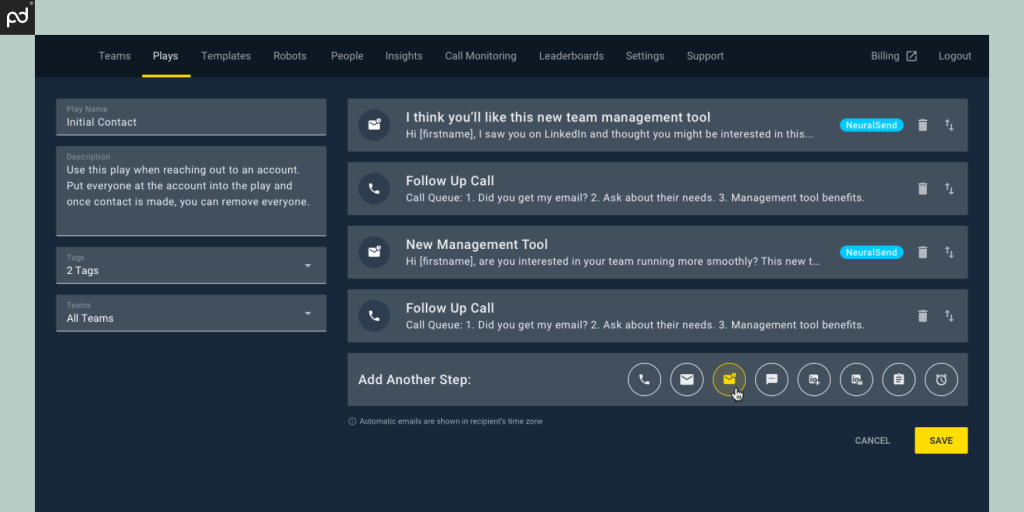
Playbooks by InsideSales guides reps on approaching customers, methods likely to earn responses, and actions needed to build strong relationships through sales pipeline management.
The platform pulls data from social media, primarily LinkedIn, and offers exclusive insights unique to InsideSales.
Beyond recommending actions, the platform pre-writes emails, selects suggested content, and creates systematized materials for reps to use.
Accessible from anywhere, it sends notifications to reps’ phones and desktops, enabling quick actions to advance deals.
Additionally, when reps start a play, others in the organization are notified, preventing overlap and ensuring coordinated efforts.
How we selected our top collaboration tools
To accurately select and assess the best sales team collaboration tools, we analyzed positive and negative assessments from over 25 reputable software-review and user-review websites, including Capterra and G2.
To determine a website’s authority, we grouped data sources into five cohorts based on monthly visitors (which we took from Semrush):
- >1.000.000 visitors;
- 500.000 – 1.000.000 visitors;
- 250.000 – 500.000 visitors;
- 50.000 – 250.000 visitors;
- <50.000 visitors
We gave more weight in our calculations and analysis to the websites with the highest visitor traffic and greatest domain authority, and also carefully analyzed in-depth reviews and feedback.
Moreover, we checked with our internal teams and our customers to better understand how businesses use sales software to move deals forward, what features they are looking for, and which collaborative tools benefit them the most.
Enhance the efficiency of your sales team with PandaDoc
Whether you manage on-site, hybrid, or remote teams, PandaDoc sales collaboration software can help you automate sales processes and coordinate your entire team’s sales activities.
One of the critical features of sales collaboration tools is their capability to integrate with multiple sales tools you already have in place.
This compatibility will help your salespeople transfer customer and sales data accurately across platforms.
With dozens of seamless integrations available, you and your reps can develop and send docs through our platform while storing and retrieving customer and sales data from preferred CRMs.
Check out all the tools that will help boost the productivity of each of your sales reps — schedule a free demo today and learn first hand how we can assist you!
Disclaimer
PandaDoc is not a law firm, or a substitute for an attorney or law firm. This page is not intended to and does not provide legal advice. Should you have legal questions on the validity of e-signatures or digital signatures and the enforceability thereof, please consult with an attorney or law firm. Use of PandaDoc services are governed by our Terms of Use and Privacy Policy.
Originally published September 6, 2017, updated September 17, 2024

